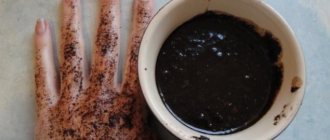For many of us, the morning begins with a cup of aromatic coffee. The dried grounds are often used as a scrub to cleanse the skin of the face and body. But there are other uses for coffee grounds. Experienced gardeners know that there is nothing better than natural fertilizers. Therefore, coffee grounds are successfully used as fertilizer. Is this method justified? Let's look at the pros and cons.
Benefits of coffee for plants
Ground coffee and boiled coffee grounds have been used for cosmetic purposes for many years. There are recipes for making face and body scrubs, tonic lotions, masks, and creams. But few people know that coffee can also be used in gardening.
Coffee beans are rich in microelements: Mg (magnesium), Ca (calcium), P (phosphorus), N (nitrogen), K (potassium). Phosphorus and potassium improve the ovary and yield of crops, and nitrogen takes an active part in photosynthesis, which will accelerate the development of the plant. Spent coffee will be useful not only for indoor and garden flowers, but also for garden crops.
Spent coffee can be used as fertilizer, regardless of the method of preparation.
The amount of useful substances is about 3% of the total volume. Therefore, coffee grounds cannot completely replace fertilizers, but they can be used as additional fertilizing.
Previously, I thought that coffee cake was only suitable for soil with an alkaline environment, since it has a fairly high level of acidity. But actually it is not. Research by scientists has shown that spent coffee has a neutral pH level. And the acid contained in whole grains is washed out when they are cooked.
From my own experience, I can note that coffee grounds help increase the yield of eggplants, carrots, radishes and tomatoes. Berries and fruit trees respond well to coffee fertilizing. Also, I noticed an increase in the number of buds and more luxuriant flowering of roses, lilies and begonias.
Another advantage of coffee fertilizing is its aromatic smell, which repels many pests, but, on the contrary, attracts earthworms, which contributes to better soil aeration.
What are the benefits of coffee grounds?
Coffee is more than just a dose of caffeine packed into a small cup. Most people, after drinking espresso or cappuccino, get rid of the grounds by throwing them in the trash. According to statistics, each person drinks 300-500 cups of coffee per year.
Assuming that we put a heaping teaspoon of coffee or 10 g into 1 cup, everyone throws out 3-5 kg of grounds annually. Before you throw away the grounds next time, you should think about how they can be reused in the garden, vegetable garden, or for plant nutrition.
Effect of coffee residues on plants
Unlike other similar fertilizers, nitrogen taken from coffee is not absorbed as quickly by crops. For example, fertilizing tomatoes takes a certain time. The chemical element becomes active only after the decomposition of microorganisms and bacteria in the soil.
Those who hope for a positive result with natural fertilization of crops should remember that its slow activation can play a negative role, because gardeners think not only about nitrogen, but also about phosphorus and potassium. Squeeze is rich in these elements in approximate proportions:
Coffee contains magnesium and copper, and calcium, zinc, manganese and iron become available after decomposition.
Many people believe that using coffee grounds in the garden leads to increased soil acidity, but almost all chemical compounds dissolve during brewing. Subsequently, a neutral acid-base balance is created, and the soil becomes a favorable environment for vegetables.
For indoor plants
It is incredibly simple and convenient to use coffee machine waste as fertilizer for home flowers. This feeding is safe, effective, and does not require additional investment. In order for the result to exceed expectations, it is better to adhere to certain recommendations:
- The soil in the pots should be allowed to dry out periodically, only then watered. Otherwise, the appearance of midges is inevitable.
- It is not permissible to pour unfinished coffee into a flower pot. The coffee grounds should be washed and allowed to dry.
- Instant coffee is completely unsuitable for watering flowers due to its high acidity.
- It is better not to use cake after coffee with milk. Milk serves as a favorable environment for the proliferation of pathogenic microflora.
- Do not sprinkle homemade flowers with pure cake. You definitely need to mix it with soil. Otherwise, it will soon become compressed and block the access of oxygen.
- Before feeding flowers with coffee fertilizer, you should make sure that this idea is advisable. It is contraindicated for many flowers.
The cake will appeal to: domestic roses, all types of palm trees, ferns and ficus trees. You can add coffee raw materials approximately once every 30 days (dosage – 2 large spoons of dry mass per 5 liters). The cake is scattered over the surface and covered with soil on top.
This fertilizer is very effective on viola and asparagus. These plants, receiving magnesium and nitrogen, begin to grow and bloom especially intensively.
Under heathers, acidophilus, and azaleas, you can add regular ground coffee. It will just acidify the soil, giving them a powerful shake-up and an incentive to grow.
Some gardeners use this recipe: take grounds (half a glass), hay dust (25 grams), 30 g of foliage. Stir, sprinkle with earth and allow to rot for a month. It’s better to do all this in an old saucepan or other unnecessary container.
The resulting substrate is added to flower pots, sprinkled with soil, and watered abundantly. This recharge is especially good in spring and late autumn.
Cake for the garden
The role of coffee grounds as fertilizer in aerating the fertile layer and protecting against slugs is irreplaceable. The powder composition attracts earthworms, but is undesirable for slugs and snails. Also, red ants and rabbits do not like coffee: they leave the area.
To repel ants from the area, you need to sprinkle dry powder on the paths or sprinkle coffee substrate on the anthill. To repel aphids and slugs, plants are sprayed with a liquid solution.
If you need to protect your garden beds from cats, sprinkle them with a mixture of coffee grounds and orange zest.
Tomato seedlings respond well to coffee fertilizer. For tomatoes, the cake is used throughout the growing season. Thanks to the attraction of beneficial soil microorganisms and the formation of bacterial strains, the fertile layer is enriched with essential nutrients.
For berry bushes, cake is used as follows. You need to scatter 2-3 cups of dry substrate around the roots and water them with water. And when planting a young seedling, place three to four cups of dry fertilizer in the hole and water it. The cake is pre-mixed with the soil.
Note! An important property of dormant coffee is the delay in the accumulation of nitrates in vegetable fruits.
Mulching with thickets protects garden flowers and fruit trees from slugs and other parasites without the use of chemicals. Caffeine acts as a poison on pests and destroys their population. Also, the smell of coffee repels insects and other unwanted “guests” in the garden. However, it is recommended to mix the cake with soil so that it does not form a dense film around the trunk, preventing air permeability.
Pest Control
There is an opinion that coffee waste scattered on the beds can repel many pests that cannot be overcome with chemical means.
Thus, slugs and snails that actively reproduce and eat strawberries and cabbage can be expelled from the beds with coffee grounds or dry cake. Pests cannot tolerate this smell and will hasten to leave a habitat that is unfavorable for them.
In addition, gardeners are confident that coffee has the power to destroy harmful larvae. This applies to mosquito tadpoles and bedbugs.
The fruit midge is also in a hurry to leave the plants, from which an unpleasant coffee smell begins to emanate.
If you scatter the cake in places where ants are concentrated, the insects will quickly leave their habitat.
If the neighbor's cat has been frequenting the beds, using them for his toilet chores, it's time to take up the coffee cake. They should fertilize the beds generously. Cats cannot stand the strong smell of coffee at all.
Some gardeners use a mixture of coffee machine waste and orange peel to repel small mammals. Others go even further and add a few drops of rosemary oil.
Preparing the Coffee Grounds
To prepare the fertilizer, you must use only used, that is, boiled coffee. Ground but not boiled grains have too high acidity, which can change the overall pH level of the soil, negatively affect the development of crops, and even lead to their death. For the same reason, I do not recommend pouring leftover liquid coffee under the plants.
The coffee grounds must first be dried. To do this, spread it in a thin layer on parchment paper, you can use an old sheet or towel, and leave it for a couple of days.
Only well-dried coffee can be used as fertilizer.
You can also use the oven to dry it, this will speed up the drying time, but you need to be careful not to overcook the coffee grounds. Raw or poorly dried coffee can quickly become infected with fungus, which can cause disease in the plants.
It is advisable to store coffee grounds after drying in a tightly closed container to avoid moisture and prevent the aroma from fading.
How to use grounds in the garden
It can be mixed with plant seeds (carrots, beets), this will speed up germination. A mixture of soil and dry coffee substrate is placed in planting pots for seedlings; this soil mixture gives excellent results. The seedlings grow strong and can easily be transplanted into holes.
You can also scatter the substance around the rooted seedling, which will facilitate an increase in nitrogenous substances in the fertile soil layer after each watering.
Note! If you set fire to a handful of cake in the house, all the flies and mosquitoes will fly away.
Fertilizer can be buried to a depth of about 4 mm. This method will retain moisture after watering and provide an influx of oxygen into the soil.
When planting, use compost with grounds mixed with the fertile layer in half. This will provide the seedlings with the necessary nutrition.
Also, dry grounds are simply diluted with water and irrigated green spaces.
Improving the mechanical properties of soil
Spent coffee is used as a fertilizer in the country to improve the mechanical characteristics of the soil. The soil texture is improved by the biological elements of the grounds. It is especially useful to use cake on soils of heavy texture - clayey, loamy. On sandstones, coffee cake reduces acidity, which has a beneficial effect on the composition of the fertile layer.
Note! Coffee protects the garden from weeds.
However, if you regularly use cake for mulching, the soil layer can become compacted and begin to impede air permeability. Therefore, mix the substrate with fertilizers of a larger fraction.
How to use grounds to improve soil and control pests
Spent coffee grounds are widely used in the country: in the garden, vegetable garden and greenhouse. Experienced gardeners use it:
1. For mulching plantings.
2. For light acidification of the soil.
3. To improve the mail structure. Adding dried coffee to the soil mixture makes it more airy and lighter. At the same time, it is important not to pile coffee grounds in a thick layer around the plants, otherwise they can cause the appearance of a dense soil crust that prevents free access of air and moisture to the root system of the plants.
4. In addition, coffee grounds can be used to make compost, which can later be used to grow flowers, vegetable seedlings and mushrooms. To prepare it, you need to put the following in a compost pit specially designated for this purpose:
Attention! If desired, you can also add some leaves, pine needles, bone meal, and even cardboard or paper to the mixture.
All components must be mixed well, sprinkled with soil and water on top, and then use a stick to make several holes in the pile. Useful compost will be ready for use in just 4-6 weeks. During this period, you should ensure that the pile is always wet.
5. To get rid of ants and snails. Ants cannot stand the coffee aroma and will disappear from the greenhouse if you sprinkle coffee on their nests. The same applies to snails - they will stop annoying plants if you sprinkle coffee grounds on the soil around them.
6. To wean your cat from digging holes in the garden, you should use a mixture of crushed orange peels and drunk coffee. By scattering the fragrant mixture around the plants, you can be sure that the cat will not make a toilet in the beds.
Why is coffee caffeinated?
An English botanist of Chinese origin, J. Wong, decided to test the effect of sleeping coffee on plants. He gave it to his experimental subjects in the most gentle way: by mulching the soil. At first, a weak, unstable positive effect was observed, and then some plants began to wither, while others looked no better than the control ones.
For Wong there was no secret here: as a specialist, he knew perfectly well why some plants accumulate alkaloids in their seeds. Henbane and datura are mentioned at first for a reason: they, and especially their seeds, are also saturated with alkaloids. Not caffeinated, but deadly poisonous.
Alkaloids for plants are a means of survival. Released into the environment, these substances suppress the vital activity of competing plants, and plants - their reservoirs - protect them from eating and pests. Why plants in mid-latitudes need chemical warfare agents is a special question. But with a coffee tree or bush, everything is clear: coffee as a plant is native to subtropical and tropical dry steppes and semi-deserts. Under these conditions, there is fierce competition for places suitable for seed germination and seedling growth: both are possible only in the short wet season.
Coffee berries are readily eaten by local animals. Their grains pass through the intestines of herbivores undamaged; Moreover, the germination rate of coffee seeds only increases. By the beginning of the rainy season, the manure with which the coffee seeds came out decays and fertilizes the soil. With the first drops of moisture, the seeds, set “on alert” by the digestive organs of the spreading animals, are activated and begin to secrete caffeine, suppressing the germination and growth of young competitors. Therefore, advice to add used coffee to the ground for seeds and seedlings is nonsense. You will thereby treat your pets with germination and growth inhibitors.
The second means of coffee’s struggle for survival is the increased acidity of the seeds, due to the presence of the same alkaloids. The awakened coffee seed acidifies the soil within a radius of 10-12 cm to pH=(5.7-5.8), this is high acidity. The bedrock soils in coffee growing areas are alkaline; The native plants on them are halophytes and halophiles. Even ephedra and tamarisk seeds do not germinate in soil with a pH <6.2. Moreover, moisture with a reaction pH = (5.7-5.8) and animals' tongues are pinched - young juicy coffee sprouts are thus protected from being eaten.
Note: Roasted coffee produces an extract with an acidity of approx. pH=6. Wet coffee cake fresh from a cezve (Turk) or coffee machine has a pH of approx. 6.2-6.3. The pH of dried, sleeping coffee increases to 6.5-6.9, i.e. its chemical reaction remains slightly acidic and never becomes alkaline. The decrease in acidity is caused by the breakdown and extraction of caffeine during heat treatment.
Nutritional value of coffee for plants
The amount of nutritional components in coffee grounds depends primarily on the preparation method. During vacuum cooking, most proteins, amino acids, potassium, and magnesium enter the water. With the Turkish method of preparing coffee, more nutritional components remain.
It is believed that caffeine inhibits the growth of crops, but after heat treatment there is little of it left in the cake, so coffee is used safely as a fertilizer for indoor plants.
Coffee is also used fresh. True, ground it contains a lot of active nitrogen, which, when decomposed, releases ammonia and can harm the root system.
Because of its ability to increase the acidity of the soil, ground coffee benefits plants that prefer low soil pH - rhododendrons, heathers, azaleas, hydrangeas.
After digestion, the pH level decreases several times, so there is no danger to plants. It is better to first soak ground coffee as a flower fertilizer in water, then spray or water it at the root.
What plants are coffee grounds used for?
Coffee sediment is used for various crops, including flowers.
For indoor flowers
Coffee grounds as a fertilizer for indoor plants are not recognized by all plant growers. This method is most suitable for cacti and orchids: they will gratefully respond to adding 1 tsp before watering. dry residue (frequency – no more than once every 2 weeks during the active growing season).
For garden flowers
The sediment in a cup of ground coffee is used as fertilizer when working in flower beds. Large-leaved hydrangeas, as well as some annuals, respond with abundant flowering to dry fertilizing or watering with coffee grounds:
- osteospermum
- petunias;
- lobelia;
- eustoma.
When planting flower seedlings in open ground to fertilize the soil, the hole is filled 1/3 with coffee. During the season, feed 2-3 times with coffee grounds diluted in water.
For vegetable and fruit crops
Coffee substrate is suitable for fertilizing flowers and as a preparation against garden slugs.
In gardening, coffee cake is used to improve soil structure. When digging tree trunks and strawberry rows, coffee substrate is added to the soil at the rate of 2 tbsp. spoons per 1 m2.
Coffee grounds - benefits for vegetables
Due to its high potassium content, coffee cake is used for growing tomatoes, cucumbers, potatoes and other vegetable crops. If it is possible to get a lot of coffee residues somewhere, and these are cafes, restaurants, private stores, then you can make fertilizing for fruit trees. Fruiting next year will be better.
Flowering ornamental plants that need potassium, starting from the budding period, also respond to the introduction of coffee cake - used as mulch or by watering.
Coffee grounds are used not only for fertilizer. It attracts earthworms to the site, which help improve soil aeration, and also release coprolites rich in humic acids into the soil.
How to use coffee grounds to control insects
Coffee not only increases the acidity of the soil, it serves as a deterrent to pests. The cake repels snails, slugs and other inhabitants that interfere with the normal growth of garden and indoor plants. For prevention, it is scattered over the flower garden and vegetables. Spent coffee is mixed with orange peel and rosemary oil. Such scents do not attract cats or dogs.
Instant coffee against slugs
Dilute 2 tsp in a glass. coffee with hot water (a little cognac can be added there) or whiskey, cool and pour into a sprayer. Treat the cabbage with the prepared liquid. The worms die, but to prevent them from multiplying, you need to water the vegetables at least once a week. Inexpensive, finely ground coffee may be suitable for such purposes.
Some gardeners show curious ingenuity. Before scattering the seeds, coffee cake is mixed with them, and thanks to a little trick, carrots and radishes germinate faster than usual. For cultivation, gardeners use only pure extraction without additives:
Before use, summer residents advise rinsing the grounds to get rid of unnecessary fillers.
During the summer, summer residents put all organic residues in a compost heap or use them as fertilizer. In winter, as a rule, all food waste and coffee waste from the coffee machine go into the trash. But in the spring you can arm yourself with organic matter if you collect it.
Coffee delicacy for seedlings of tomatoes and peppers
Young shoots of garden crops become stronger and bear fruit better in the future when they are fed with organic waste. Just like coffee lovers, some plants need this treat.
Indications for use
So, the benefits of adding coffee grounds in the country or in indoor gardening can be determined (in descending order of priority):
- Slow release of active nitrogen: amide must be converted into ammonium, and that into nitrate, assimilated by plants. Both in the case of fertilizing with coffee grounds are easily regulated by moistening the soil, because It holds amide nitrogen tightly in dry form.
- For indoor plants that require slightly acidic soil pH. Potting soil often becomes alkalized due to watering with tap water.
- As a biocidal agent for composting food waste and for pest control - the effect is due to alkaloids.
- As a mulch attractor for soil structuring organisms, also when composting in a mushroom culture.
Coffee as fertilizer
Using coffee residues as fertilizer for the garden is advisable:
- Firstly, for adult plants that have entered the phase of fruiting or accumulation of nutrients in storage organs (except for asparagus, see below).
- Secondly, such plants must have fairly effective filters that prevent inhibitory substances from entering the green mass. These include root vegetables (carrots, beets, radishes, turnips) and legumes.
The use of sleeping coffee for feeding root crops is valuable, firstly, because the accumulation of nitrates in the fruits is excluded. Secondly, fruits produced on alkaline soils (calcareous, brackish) are just as juicy and sweet as on neutral soils. In both cases, coffee grounds are used to mulch the soil under the root crops to a depth of 5-6 cm, calculating up to 20 g of dry coffee residues per 1 square meter. m beds.
For legumes, wet coffee grounds are simply scattered under the plants at a rate of 5-10 g per 1 square meter. m of planting. In this case, the effect of fertilizing coffee affects the juiciness and sweetness of the fruit. The nutritional quality and keeping quality also improve slightly: the beans become more boiled, and dried peas are less attractive to “worms” - the larvae of food supply pests.
Note: cabbage, tomatoes, cucumbers, and potatoes do not need to be fed with coffee. The leaves in the head, fruits and tubers will turn out dryish, stringy, and tasteless. A special article is asparagus (asparagus). Its yield from feeding coffee drops noticeably, but the edible sprouts are denser and tastier.
Coffee for flowers
A number of ornamental flowering plants, both in pots and in open ground, respond poorly to the soil reaction going beyond the slightly acidic pH = (6.8-6.5): flowers/inflorescences become smaller, change color, and lose their durability when cut. In this case, using dried coffee grounds from flowers can help matters for:
Rose flower, which will benefit from feeding with coffee grounds
- polyanthus (climbing, climbing) roses - if flowering becomes less abundant, the flowers become smaller and fall off early;
- tea and hybrid tea roses - when the flowers turn pale, lose their fullness, venation appears in the color (see picture on the right), cut flowers quickly wither;
- hydrangeas – less abundant flowering, the inflorescences are loose and smaller;
- azaleas - the color of the flowers changes, many buds fall off without blooming.
In all cases, the soil is mulched with dry coffee waste, according to the norm for root crops, see above, but the area of the trunk (bush) circle is taken into account. Watering is increased, preventing soil acidification; When the surface crust dries on it, loosening is carried out. When signs of recovery appear, watering is reduced to the average norm; loosening continues.
Note: about using coffee grounds to feed indoor plants, see also the video below:
Video: using coffee for indoor flowers
Coffee against pests
In order to combat garden pests, coffee is used as a contact poison for organisms with permeable integuments or as a source of an odor that is unbearable for pests. The first method is quite expensive, because... Either instant coffee is used, or, for a longer action, ground coffee, see for example. video about using coffee against slugs:
Video: using coffee against slugs
In the second case, dry coffee grounds help against harmful flies and wasps. The spent coffee is thoroughly dried and mixed with any saltpeter in the proportion (20-30): 1 by volume, i.e. add a little saltpeter to the coffee waste. In calm weather, the mixture is laid out in heaps in the garden or vineyard on fireproof stands and set on fire. Coffee smoke does not harm plants, but sweet tooth parasites will turn their noses up at the fruit for up to 2 weeks or more.
A little known, but works well method of fighting earth ants using coffee grounds: they are dumped wet at the entrance(s) to the anthill and, if there is a lot of coffee residue, on the ant paths. “Fraers” (sorry) are, as always, ruined by greed: caffeine acts like an intestinal poison on thieving ants.
Coffee in compost
How to properly dispose of food waste for composting
Coffee grounds for composting are placed on a pile (in a hole, box) between 2 layers of food waste; the result should be a layer of 10-15 cm. Layers of food waste alternate with layers of earth of the same thickness, see fig. on right. Anaerobic bacteria, which carry out the initial decomposition of organic residues, are not sensitive to caffeine, but it will suppress the activity of putrefactive bacteria and mold fungi in food waste. Caffeine will not penetrate into the soil from the dense mass of waste and will not harm the beneficial bacteria in it. Thus, caffeine will contribute to the decomposition of waste on the verge of rotting and fermentation, which is required to obtain high-quality compost. Additionally, the insoluble solid mass of coffee grounds structures the layers of food organics: they will become more accessible to such unsurpassed soil formers as earthworms.
Note: to the chagrin of amateur fishermen, fish do not bite on compost worms. Especially if coffee waste was added to the compost. Either the worms are too fatty and sugary, or they don’t smell right - that’s up to the fish’s mind.











